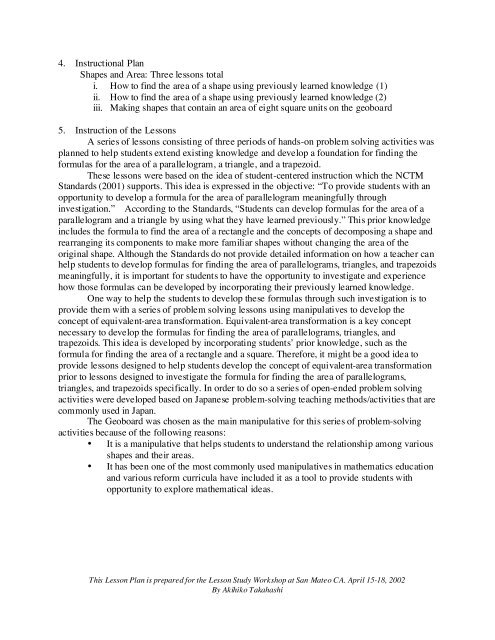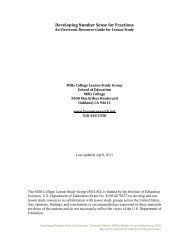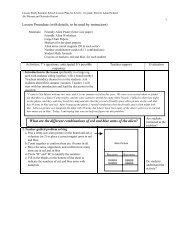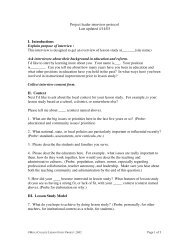4th Grade mathematics Lesson Plan - Lesson Study Group at Mills ...
4th Grade mathematics Lesson Plan - Lesson Study Group at Mills ...
4th Grade mathematics Lesson Plan - Lesson Study Group at Mills ...
You also want an ePaper? Increase the reach of your titles
YUMPU automatically turns print PDFs into web optimized ePapers that Google loves.
4. Instructional <strong>Plan</strong><br />
Shapes and Area: Three lessons total<br />
i. How to find the area of a shape using previously learned knowledge (1)<br />
ii. How to find the area of a shape using previously learned knowledge (2)<br />
iii. Making shapes th<strong>at</strong> contain an area of eight square units on the geoboard<br />
5. Instruction of the <strong>Lesson</strong>s<br />
A series of lessons consisting of three periods of hands-on problem solving activities was<br />
planned to help students extend existing knowledge and develop a found<strong>at</strong>ion for finding the<br />
formulas for the area of a parallelogram, a triangle, and a trapezoid.<br />
These lessons were based on the idea of student-centered instruction which the NCTM<br />
Standards (2001) supports. This idea is expressed in the objective: “To provide students with an<br />
opportunity to develop a formula for the area of parallelogram meaningfully through<br />
investig<strong>at</strong>ion.” According to the Standards, “Students can develop formulas for the area of a<br />
parallelogram and a triangle by using wh<strong>at</strong> they have learned previously.” This prior knowledge<br />
includes the formula to find the area of a rectangle and the concepts of decomposing a shape and<br />
rearranging its components to make more familiar shapes without changing the area of the<br />
original shape. Although the Standards do not provide detailed inform<strong>at</strong>ion on how a teacher can<br />
help students to develop formulas for finding the area of parallelograms, triangles, and trapezoids<br />
meaningfully, it is important for students to have the opportunity to investig<strong>at</strong>e and experience<br />
how those formulas can be developed by incorpor<strong>at</strong>ing their previously learned knowledge.<br />
One way to help the students to develop these formulas through such investig<strong>at</strong>ion is to<br />
provide them with a series of problem solving lessons using manipul<strong>at</strong>ives to develop the<br />
concept of equivalent-area transform<strong>at</strong>ion. Equivalent-area transform<strong>at</strong>ion is a key concept<br />
necessary to develop the formulas for finding the area of parallelograms, triangles, and<br />
trapezoids. This idea is developed by incorpor<strong>at</strong>ing students’ prior knowledge, such as the<br />
formula for finding the area of a rectangle and a square. Therefore, it might be a good idea to<br />
provide lessons designed to help students develop the concept of equivalent-area transform<strong>at</strong>ion<br />
prior to lessons designed to investig<strong>at</strong>e the formula for finding the area of parallelograms,<br />
triangles, and trapezoids specifically. In order to do so a series of open-ended problem solving<br />
activities were developed based on Japanese problem-solving teaching methods/activities th<strong>at</strong> are<br />
commonly used in Japan.<br />
The Geoboard was chosen as the main manipul<strong>at</strong>ive for this series of problem-solving<br />
activities because of the following reasons:<br />
• It is a manipul<strong>at</strong>ive th<strong>at</strong> helps students to understand the rel<strong>at</strong>ionship among various<br />
shapes and their areas.<br />
• It has been one of the most commonly used manipul<strong>at</strong>ives in <strong>m<strong>at</strong>hem<strong>at</strong>ics</strong> educ<strong>at</strong>ion<br />
and various reform curricula have included it as a tool to provide students with<br />
opportunity to explore m<strong>at</strong>hem<strong>at</strong>ical ideas.<br />
This <strong>Lesson</strong> <strong>Plan</strong> is prepared for the <strong>Lesson</strong> <strong>Study</strong> Workshop <strong>at</strong> San M<strong>at</strong>eo CA. April 15-18, 2002<br />
By Akihiko Takahashi






